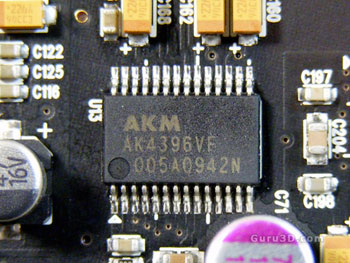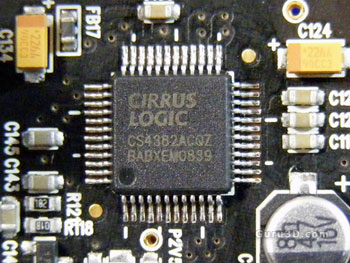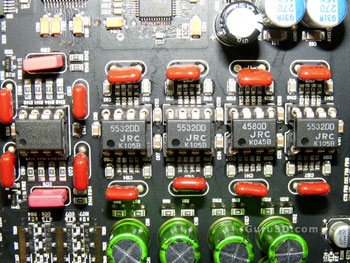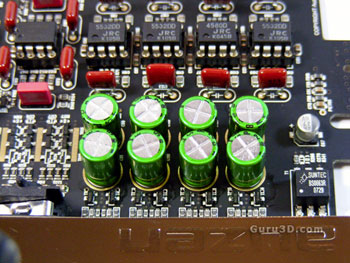Electronics Overview
Electronics Overview
We add this section to our audio reviews so the readers can see where their hard earned dollars will be going to help them understand what they are really buying when they purchase such a product.
First up, Digital to Analog Converters (DAC's)
Headphone Output, AK4396 - The Digital to Analog converter used for the headphone output is the AK4396. This DAC is an advanced multi bit Delta Sigma Architecture unit and has a Signal to Noise Ratio and Dynamic Range of 120dB. This units features oversampling of 128X and an 8X 24bit digital filter and offer a low THD-N value of 100dB.

This DAC is used in many high end audio units and has won various awards such as the Audio Excellence award for 2007 and in the industry is referred to by many as the ¡°Miracle DAC¡± for offering low distortion and a high dynamic range.
Multi channel Analog Output CS4382A - This Digital to Analog Converter (DAC) chip features advanced Multi-bit architecture and provides high quality output for up to 24/192 KHz. This converter has a dynamic range of 114dB and a THD+Noise value of -100dB. The chip also offers a low sensitivity to jitter and on chip selectable filters.

This Digital to Analog Converter IC is used for the Multi-channel Analog outputs on the Bravura. For a design standpoint these chips have been used with great success on another Auzentech design namely the Forte 7.1.
Cirrus Logic CS4382 Specifications Sheet
Operational Amplifiers (Opamps) - It is nice to see Auzentech returning to their roots and using an opamp socket for every stereo pair. The sockets used on this card are not cheap generic units they are a higher quality machined socket which can last through many opamps changes. Another point that we find unique on this card is the designers actually used three different opamp models.

We have:
LME49720 (Headphone output) - Left - This opamp has becoming very popular among the DIY crowds and audio designers. According to National Semiconductor this chip is a model variation to the famed LM4562. Some people suggest they can hear differences between the two, suggesting the LME49720 is a higher quality chip and other suggest they are the same. In either case they are far from a generic opamp and they sound quite good.
NE5532 (Fronts, Rears and Side) - This chip can be defined as THE generic audio opamp. Probably the most widely used audio opamp in history this amp can be found in a great deal of audio gear from professional studio mixers to receivers, amplifiers and everything in between. While newer chips may have better specs, many designers will still call upon this unit for familiarity and time tested sound quality.
JRC4580 (Center and Subwoofer) - This is another generic audio opamp which Auzentech choose for its sound signature to power the center and subwoofer outputs. This unit produces a bit more bass impact then some others which is probably the reason it was chosen for the stock chip for the Center/Subwoofer output.
These opamps are all in sockets and ultimately they can be changed by the end user to further tune the sound or improve sound quality using higher grade models.Capacitors - Auzentech opted for higher grade capacitors in many parts of the design then what is generally seen on soundcards. At their base function, Capacitors form your cards filters and are used for various other audio tasks.

It is generally suggested that good capacitors can make an audio source notably better. Similar quality capacitors are also used on Auzentech other soundcards such as the Forte 7.1 and Home Theater HD 7.1
